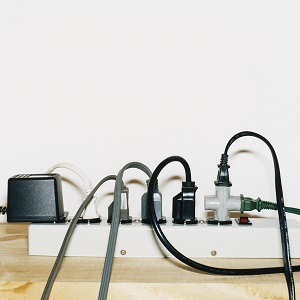DO SURGE PROTECTORS PREVENT FIRES
DO SURGE PROTECTORS PREVENT FIRES
Surge protectors can help prevent fires if they are used properly and are in good working shape. However, if there is a faulty or defective unit, or if it is being used improperly, surge protectors can actually cause electrical fires. According to the Electrical Safety Foundation International (ESFI), over 3300 housefires are caused each year by defective or improperly used surge protectors, power strips and other electrical cords. See below for tips to ensure that you are using surge protectors in the proper manner, to keep your family and home safe from a fire.
TIPS TO PREVENT FIRES WITH SURGE PROTECTOR
It is important to know the difference between a power strip and a surge protector. A power strip only adds extra outlet space to plug in electrical equipment. A surge protector blocks or diffuses voltage spikes or surges that can damage electrical equipment. Surge protectors will be labeled as such, as well as having a rating for ‘joules,’ which are measurements of energy. At a minimum, a household surge protector should have a rating of 600 joules or more to protect electrical equipment in the case of a power surge or spike.
What is a power surge? A power surge is a spike of an electrical current that occurs suddenly and usually stops right away. Electronics and appliances can still be damaged even if the spike only lasts a second. Power surges can be caused by faulty wiring or high-power use devices, such as an air conditioner or refrigerator when they turn on or off.
SURGE PROTECTOR SAFETY
DO:
Only use surge protectors that have an internal circuit breaker, as it will trip the breaker if it is overloaded or shorted. Only use surge protectors that are UL or ETL approved and leave this label on the unit and have either a polarized plug or a three-prong grounded plug. Always unplug a surge protector that is not in use.
Visually inspect all surge protectors on a regular basis to ensure they are not damaged or faulty. Also, ensure that the surge protector is fully engaged in the outlets. Remove and replace surge protectors that are hot to the touch, as the electrical load could be overloaded.
Surge protectors should be replaced if you have been hit by a power surge or electrical storm.
DON’T:
Do not use surge protectors near a moist environment or in any area where the unit would be covered with carpet, furniture or other items that would limit air circulation to the unit.
Do not plug in more than one surge protector into a single duplex electrical outlet.
Do not staple or tack or tape down any surge protector.
Do not plug in medical equipment into a surge protector unless it is specifically approved for this purpose.
For more information visit https://www.esfi.org/
